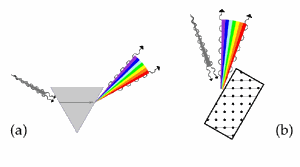From Physics News Update 805, December 2006
by Phil Schewe, Ben Stein, and Davide Castelvecchi
In 1670 Isaac Newton demonstrated the composite nature of sunlight when he sent a carefully collimated sunbeam through a prism, which spread out the light into a rainbow of colors; by sending a beam of single color through a second prism (with no further spreading) Newton showed that the color was not being imposed by the prism but was intrinsic to the light itself. Now, physicists using XOR beamline 3-ID the U.S. Department of Energy's Advanced Photon Source at Argonne have spread out a beam of x-rays (which are, after all, just a more energetic version of visible light) into a rainbow of colors.
Trying to reflect x-rays from a surface is difficult because x-ray wavelengths are some 10,000 times shorter than those for visible light. Glancing reflection of only a few tenths of a degree is normally possible, and even then the beam of x-rays will suffer very little wavelength-dependent spreading. However, another phenomenon, Bragg diffraction, allows for scattering of x-rays from a crystal through large angles; in this case the incoming x-rays scatter not merely from a top layer of atoms in the crystal but from numerous atomic planes. Furthermore, if the atomic planes are not parallel to the crystal surface the diffracted x-ray beam will be spread out prismatically into a range of component wavelengths (or colors).
In the Argonne experiment an incoming beam of 9-kiloelectronvolt x-ray photons with angular spread of only 1 micro-radian (two-tenths of an arcsecond) was backwards scattered and spread out into an x-ray rainbow with an angular dispersion of 230 micro-radians (see figure).
Argonne physicist Yuri Shvyd'ko says that his rainbow is not just a novelty but will have many practical applications in x-ray optics. These include compression of x-ray pulses in time and the development of x-ray monochromators (which fashion x-ray beams of pure wavelength, or color) and much higher-resolution x-ray spectrometers.
Contact: Yuri Shvyd'ko (shvydko@aps.anl.gov)
See: Yu.V. Shvyd'ko , M. Lerche, U. Kuetgens, H. D. Rüter, A. Alatas, and J. Zhao, "X-Ray Bragg Diffraction in Asymmetric Backscattering Geometry," Phys. Rev. Lett. 97, 235502 (2006). DOI: 10.1103/PhysRevLett.97.235502
The original story can be found here. Article and graphic © 2006 American Institute of Physics
Use of the Advanced Photon Source was supported by the US Department of Energy, Office of Science, Office of Basic Energy Sciences, under Contract No. W-31-109-ENG-38.
Argonne is a U.S. Department of Energy laboratory managed by UChicago Argonne, LLC

